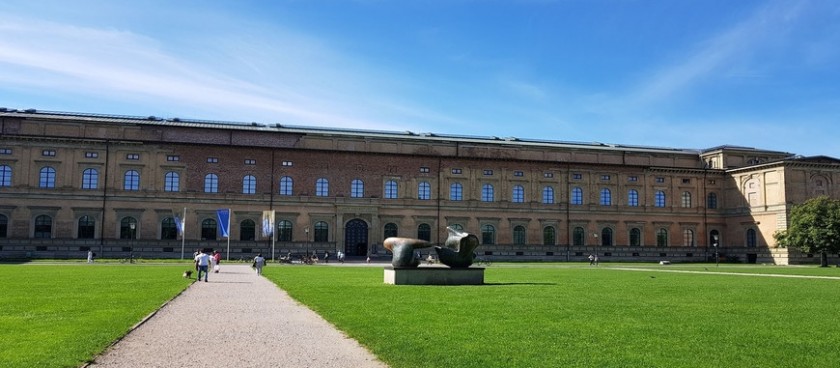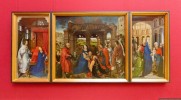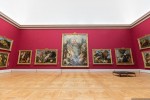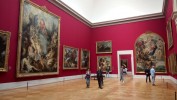- #DE50
- Barer Str. 27, 80333 München, Germany
- +498923805216
- info@pinakothek.de
- https://www.pinakothek.de/
- Working hours*:
Every day, from 10:00 to 18:00,
Tue and Wed until 20:30.
Mon - closed. - Prices*:
Adult ticket 7 €, students and pensioners 5 €, children under 18 free of charge.
On Sundays admission is 1 €. - * - opening and closing times as well as entrance prices, are subject to alterations without notice. Visitors are advised to check before visiting.
- 48.1482984, 11.5699740 Copy to clipboard Copy
-
#Museums
This Museum of Fine Arts contains a pictorial collection of European masters from the Middle Ages to the 19th century.
According to the name, which means "a collection of paintings" in translation, only paintings kept in the Pinakothek.
After the upheavals of the French Revolutions, King Ludwig I of Bavaria (Ludwig I. von Bayern) decided to make the royal art collection available to the public. Especially for this purpose, Ludwig I decided to build a royal art gallery and commissioned the court architect Leo von Klenze to create a worthy project.
Construction work began in 1826. At the time of their completion, the building of the Royal Art Gallery was considered the largest museum building in the world and later became a model for museums around the world. It was Leo von Klenze who subsequently executed the building of the New Hermitage in St. Petersburg.
Leo von Klenze designed the Pinakothek, his masterpiece of architectural art, at the same time luxurious and functional. Large rooms, additionally illuminated by upper windows and glass roofs, are combined with study rooms in the northern wing of the building.
The basis of the exhibition of the art gallery was made up of works specially made to order by Wilhelm IV and, later, Maximilian I - Albrecht Altdorf, Peter Paul Rubens, Albrecht Durer. The grandson of Maximilian I, Maximilian II, as governor of Antwerp, acquired a large number of paintings by Dutch and Flemish masters. After the unification of Bavaria with the Palatinate, the collection of paintings was replenished with works by Raphael, Rembrandt, Boucher and other artists.
During the construction of the Royal Gallery building, Ludwig I, through his art agents, actively purchases paintings by great masters, giving preference to old German artists and works of the Italian Renaissance. So in 1827-1828 , the collections of the brothers Sublitz, Buisser, Counts Wallenstein were acquired, Raphael's work "Madonna with a Curtain" was acquired in Italy.
In 1836, the Pinakothek was opened then, of course, without the prefix "old", it was the only one. It is much later that the New Pinakothek and the Pinakothek of our time will appear.
The very name "Pinakothek" was chosen by Ludwig I and means, translated from ancient Greek - "collection of paintings".
During the Second World War, the building of the Pinakothek seriously damaged by bombing. The paintings, fortunately, had been evacuated by that time. The restoration project of the Old Pinakothek building, carried out in 1957, involved the deliberate use of bricks different from that used in the main building. This restoration caused public controversy, but still, the building remained with the stains of the war.
Pictures of the Old Pinakothek in Munich
Of the many thousands of the museum's collection, the permanent exposition of 19 halls and 47 offices on two floors presents 700 paintings.
German painting of the XIV - XVII centuries
One of the main masterpieces of the Old Pinakothek is the work of Alfred Durer "Self-portrait in clothes trimmed with fur" (1500). An unusual angle, colours, and most importantly, the gaze of the depicted man attracts attention. Drawn on a blackboard by the 28-year-old artist, the self-portrait resembles the image of Christ. The collection of the museum contains a large collection of Alfred Dürer because he was from Bavaria, Nuremberg.
The work of Alfred Altdorf "Battle of Alexander" ("Alexanderschlacht / Schlacht bei Issus") from the historical cycle, written in 1524, and today amazes with the scale of the image and the unusual colours
Works by old Dutch masters
The Alte Pinakothek contains the works of almost all "Old Dutchmen". The most popular is a fragment of the work of Hieronymus Bosch "The Last Judgment". In addition, there are paintings by Rogier van der Weyden, Dirk Bouts, Hans Memling and other artists.
Flemish painting of the 16th - 17th centuries
The collection of Flemish paintings in the museum is very significant, and includes works by Pieter Brueghel, Jan Brueghel, Antonis van Dyck, Adriaen Brouwer and other masters.
A special place in the collection of the Old Pinakothek is occupied by the painting by Bruegel the elder Peter "The Country of Lazy People". The picture is full of irony and satire. Before you get to the Land of lazy people, you need to eat a mountain of porridge. On the right side of the picture is the new lucky one, falling into the country with the river of milk, which is depicted on the horizon. Everywhere - ready-made food and drink - a running fried pig with a fork in its side, an egg, already opened, with a spoon inside, runs towards, on the roof of the house - plates of pies. In the centre of the image, there are overeating representatives of three estates - a knight, a peasant, a clergyman. Bruegel denounces mortal sins in his painting.
The Alte Pinakothek has 72 canvases by Peter Paul Rubens. This is the world's largest collection of works by Rubens; his works occupy four halls. Many works were at one time made by Rubens especially for the order of the Bavarian dukes of Wittelsbach.
The huge (6 meters by 4.6 meters) painting by Rubens "The Last Judgment" is famous. It was commissioned by Duke Wolfgang Wilhelm for the altar of the palace church in Neuburg on the Danube. However, due to the abundance of nude figures, the painting was removed from the church.
Dutch painting of the 17th century
The central point of the collection of Dutch Baroque painting is the early works of Rembrandt "Self-portrait", "Holy Family", "Descent from the Cross".
Another masterpiece of the Alte Pinakothek collection is a self-portrait by Rubens. In a self-portrait, Rubens portrayed himself with his first wife, Isabella Brant. Art critics see in a manner atypical for Rubens, a resemblance to the painting by Jan van Eyck "Portrait of the Arnolfini Couple". Many things were unusual in the portrait - both the large full-length image, and the ease of poses, and the equal image of both spouses, at the same level. Critics call this painting "a portrait of a marriage."
Italian painting from the 14th to the 18th century
The exhibition of Italian painting begins with the Italian Gothic period. Among other interesting works, there is the famous painting by Giotto "The Last Supper".
From the collection of the Italian Renaissance period, the museum is especially proud of the works of Titian "Madonna and Child at Sunset", "Earthly Love or Vanitas", Raphael Santi "The Holy Family of Canigiani", "Madonna Tempi", Sandro Botticelli "Lamentation of Christ".
The Old Pinakothek has the only painting by Leonardo da Vinci - "Madonna of the Carnation". Da Vinci completed this work when he was 19 years old, not yet having developed his style, therefore, initially, even with the purchase, the painting was taken to the pen of another master.
Spanish painting of the 16th - 17th centuries
Among the masterpieces of Spanish painting in the collection of the Old Pinakothek, one should especially note the works of El Greco "Taking the Clothes from Christ" and Diego Rodriguez de Silva Velazquez "Portrait of a Young Man".
French painting of the 17th and 18th centuries
A special place in the collection of French painting occupied by the works of Nicolas Poussin "Bacchus and Midas", Jean Baptiste Simeon Chardin "Woman cleaning a turnip" and Leopold von Bode "The Saga of Pepin and Bertha".



